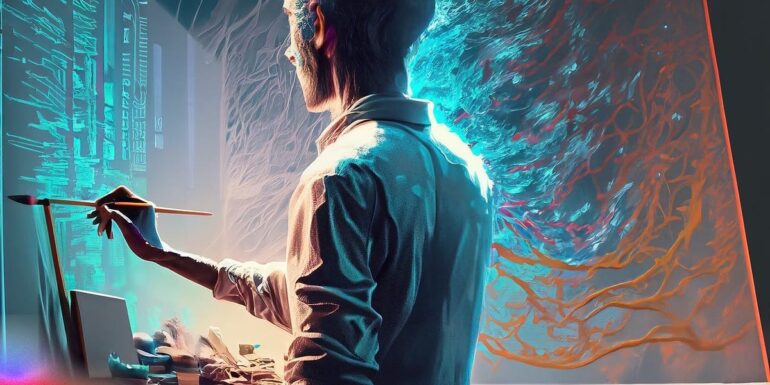TL;DR:
- Artists’ copyright infringement claims against AI art generators face obstacles.
- US District Judge William Orrick dismisses most claims, citing deficiencies.
- Questions arise about the existence of copyrighted images in AI systems and artists’ ability to prove infringement.
- Claims for direct infringement against Stability AI proceed while others are dismissed.
- The key challenge is demonstrating the use of artists’ works in training AI systems.
- Opacity surrounding training datasets poses a significant hurdle.
- The judge urges plaintiffs to clarify their theories and evidence.
- President Joe Biden issued an executive order addressing AI safeguards.
- Copyright and intellectual property protection are highlighted in the AI Executive Order.
- Self-regulation by leading AI companies lacks enforceable commitments.
Main AI News:
In a groundbreaking lawsuit, artists seeking compensation for the unlicensed use of billions of internet-sourced images in generative artificial intelligence (AI) art generators have encountered a significant obstacle. US District Judge William Orrick has dismissed most of the copyright infringement claims against Midjourney and DeviantArt, citing various deficiencies in the accusations. These legal actions revolve around the uncompensated and unauthorized utilization of images to train AI systems. The judge’s decision raises questions about whether AI systems indeed contain copies of copyrighted images used to create infringing artworks and whether artists can substantiate infringement claims in the absence of identical AI-generated material.
Claims of infringement, right of publicity violations, unfair competition, and breach of contract against the companies have been dismissed, though they may be reasserted at a later stage. Notably, a direct infringement claim against Stability AI has been allowed to proceed, as it is alleged that the company used copyrighted images without permission to develop Stable Diffusion, an AI model within its DreamStudio image generator. However, Stability AI contends that its model does not involve wholesale copying but rather focuses on the development of parameters like lines, colors, and shades, derived from copyrighted works. The key point of contention, which may determine the case’s outcome, remains unresolved.
The artists must now establish that their works were used to train AI systems, particularly in the case of DeviantArt’s DreamUp and Midjourney, which are believed to be powered by Stable Diffusion. However, the opacity surrounding training datasets poses a significant challenge for the artists.
Judge Orrick’s dismissal of the infringement claims underscores the need for plaintiffs to clarify their theories regarding compressed copies of training images within Stable Diffusion. Additionally, questions have arisen about whether Midjourney and DeviantArt can be held directly liable for infringement if their AI systems contain only algorithms and instructions that incorporate limited elements of copyrighted works.
Furthermore, the absence of allegations implicating the companies in the alleged infringement has been highlighted. Plaintiffs are urged to clarify their theories against Midjourney regarding its use of Stable Diffusion and its independent use of training images. To advance their copyright claims, the artists will likely need to demonstrate the existence of infringing works produced by AI tools that closely resemble their copyrighted material, a challenging task given the nature of AI-generated output.
Despite the defendants’ strong argument for dismissal, the judge acknowledged the possibility that AI tools could create materials similar enough to artists’ works to be mistaken for fakes. However, claims of vicarious infringement, Digital Millennium Copyright Act violations, right of publicity breaches, breach of contract, and unfair competition were all dismissed.
Plaintiffs have been granted an opportunity to amend their claims to provide clarity and plausible facts regarding compressed copies within Stable Diffusion. They must also clarify how these copies violate copyright rights when used in products offered to third parties, such as DreamStudio, DreamUp, and Midjourney. Regarding the right of publicity claim, there is insufficient evidence to support the argument that companies used artists’ identities to promote their products.
Two of the three artists involved in the lawsuit withdrew their infringement claims due to the absence of copyright registration before filing. The remaining copyright claims are limited to artist Sarah Anderson’s works, which she has registered. Anderson’s reliance on the results of a search on “haveibeentrained.com” to demonstrate that Stable Diffusion was trained on her material will be further scrutinized during discovery.
Stability AI, DeviantArt, and Midjourney have not responded to requests for comment.
In a related development, President Joe Biden recently issued an executive order aimed at establishing safeguards against AI risks, including the potential for deep fakes. The order recommends watermarking AI-generated photos, videos, and audio to protect against misuse. The inclusion of copyright and intellectual property protection in the AI Executive Order reflects the importance of these issues to America’s creative and IP-powered industries.
During a meeting in July, leading AI companies voluntarily agreed to self-regulate and establish guardrails to manage the risks associated with AI technology. However, these agreements lack a reporting regime or timeline to legally bind the firms to their commitments, mirroring the limitations of the executive order.
Conclusion:
The dismissal of copyright infringement claims against AI art generators marks a significant legal development. The case highlights the complexity of establishing liability in AI-generated art, with implications for the intellectual property and creative industries. Artists and AI companies may need to navigate these legal challenges as AI art continues to gain prominence in the market.

